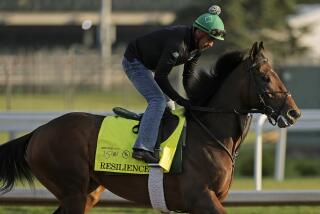Making Hay While the Sun Is Setting
- Share via
CHICAGO — Sowing fields surrounded by subdivisions, James Culver is well aware that the world around his farm has changed.
Plainfield was a sleepy stagecoach stop when his family settled there in 1834, but today it’s the fastest-growing city in Illinois. The population nearly tripled from 1990 to 2000, and has doubled again since then, according to the latest census estimates.
Culver, 75, calls himself a country boy and fills his nights reading the 1906 Sears and Roebuck catalog. He’s not just out of step with this century; he was out of step with the last one too.
In 1975, a Tribune article declared him to be among the last of a dying breed -- farmers who work their fields with draft horses, the massive beasts that once pulled everything from plows to streetcars.
Thirty-one years later, farm bureau officials in the Chicago metropolitan area say that Culver is no longer one of the last. He is the last.
He appears stronger than the average man a third his age, but Culver fears that this could be his last year in the fields. He had a triple heart bypass in 2005 and, late last month, he headed back to the hospital to have an arterial blockage in his right leg fixed.
Already he has leased much of his land to other farmers, all of whom employ heavy machinery. Culver has continued to work his hayfields, which feed his four Belgian mares.
“It didn’t used to be that hard,” he said one day recently as he struggled to remove the heavy horse tack from the only females in his life: Ruby, Dora, Connie and Jane.
“I want to keep them if I can take care of them,” he said. “I’ve never been without my horses.”
Living without horses also would have been unimaginable to Culver’s great-great-grandfather, Daniel Culver, who moved to Plainfield in 1834 -- back when it was known as Walker’s Grove. Horses pulled Chicago through the 19th century, and draft horses made up the majority of them.
“They are too fond of the heavy draft breeds, almost wholly neglecting the lighter and finer grades of stock,” an 1872 Tribune article said of farmers at the time.
Ollie Ziegler, the historian for the Belgian Draft Horse Corp. of America, said the preference was a matter of necessity.
“Back in those days, that was the only source of strong farm power,” he said.
Before the turn of the century, steam and gasoline-powered tractors and cars began filling the horse’s role in both the city and the countryside.
“1952 and 1953 were the lowest numbers of registration of any draft horse,” Ziegler said, adding that most registration gains since then can be attributed to the breeds’ increasing popularity as show and exhibition horses. “I saw the last of them leave the farms and go to the killer plants.”
On the Culver farm, though, draft horses were more than a means to an end.
Until this winter, Culver always made sure to feed the horses before he prepared his own breakfast. Now he waits until daylight before heading to the barn.
“I’m out here alone,” said Culver, a lifelong bachelor.
Although he never married -- “I guess I was too busy,” he jokes -- he is not without regular potential suitors: real estate agents.
“I get a lot of that, you bet,” he chuckled.
Culver and his sister, who lives in Lockport, Ill., own about 240 acres in the Plainfield area, which several in-town agents valued at $20 million, give or take a few million.
But turning the fields into home sites and enjoying a poolside retirement is not in the future for a man who wears work boots held together by tape and determination. The land, simply put, has never been for sale -- nor will it ever be, as long as Culver is alive.
“It’s been in the family too long,” he said.
As for the potential millions he’d get in a sale, he said, “I don’t need it and I don’t want it. And once you spend it, you never get it back.”
After feeding his horses, Culver fits them with their collars, bellybands and cruppers to ready them for the fields. He has worked in this barn since he was a boy; its walls feature several scrawls of “James” from when he was learning to write his name.
A Farmers Mutual calendar marks the time as December 1977. Culver’s aged cat, Tom, looks on with boredom.
“He used to be a pretty good mouser, but now he just plays with them,” Culver said.
Culver ends most days as the sun sets, sitting in his living room either reading or watching television. “It’s getting really hard to find something I like,” he said.
Next to his recliner are photo albums of horses he has owned over the years, gospel 45s and arthritis balm.
Often he’ll pop a tape into the VCR that shows him plowing fields of wheat. The tape, which was made to teach schoolchildren history, shows a scene just like the one passersby see on Culver’s farm every day.
“Time and time again I’ve been told I couldn’t make a living, but I’ve never worked a day in town myself,” he said, seated next to a stitched pillow that reads, “Life without horses ... I don’t think so!”
“This is all I’ve ever done.”
More to Read
Sign up for Essential California
The most important California stories and recommendations in your inbox every morning.
You may occasionally receive promotional content from the Los Angeles Times.










